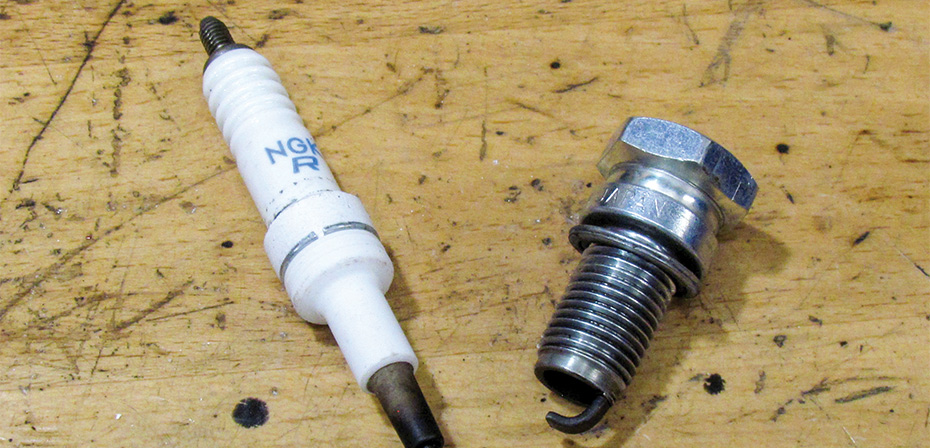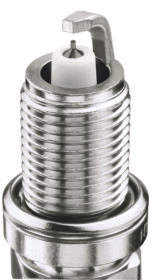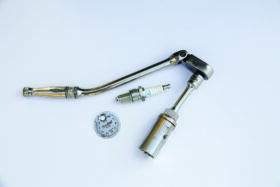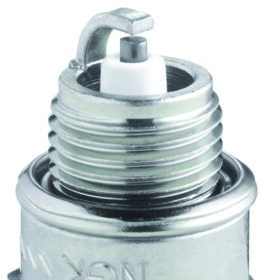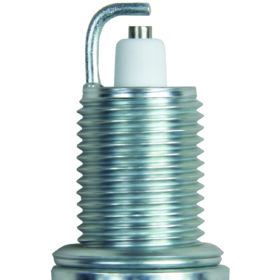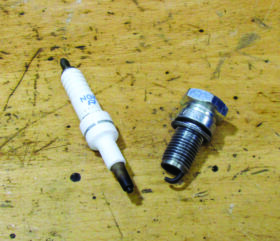Sometimes taken for granted, this simple device plays an important role in how efficiently your engine runs.
Sparkplugs spark away millions of times throughout their life cycle, yet get little attention. Their spark ignites the mixture in the combustion chamber, and the quality of that spark determines just how effectively that mixture combusts. While sparkplugs are simple devices, there’s lots you should know about how they work, and what you do know might help you decide what kind of plugs to get when it’s time to replace them.
A sparkplug has three main components: a threaded metal housing, a ceramic insulator, and a core made of conductive material. On the end of the sparkplug sticking out of the engine is a terminal onto which connects the high-voltage lead coming from the coil. The terminal is connected to the core, and at the other end of that core is an electrode. The electrode and core are insulated from the metal housing by ceramic. A curved piece of metal (the ground electrode) protrudes from the threaded end of the metal housing, and ends just above the centre electrode. The distance between the two electrodes is called the sparkplug gap. Because the core is insulated from the metal housing, when the coil sends a brief jolt of high-voltage electricity through the sparkplug wire, that electricity jumps the plug gap in the form of a strong spark, which then ignites the fuel mixture. However, there are several important factors that influence the quality of the spark, and the combustion.
 A sparkplug is designed to work within a specific heat range. Heat is produced in the sparkplug through the combustion process, and it’s the plug’s heat range that determines its ability to shed this heat. A sparkplug works best between about 500 and 900 degrees Celsius, measured at the insulator nose (the central ceramic part of the plug from which protrudes the central electrode); it is within this range that it can self-clean. Below 450 degrees, a plug will have a tendency to foul, since carbon deposits are too cool to burn off. Carbon acts as a conductor, and excessive build-up will essentially short-circuit the plug between the electrodes, thus preventing the spark from jumping the gap — if you ride a two-stroke you know about fouled plugs. If a plug operates at temperatures above 900 degrees it will overheat, which can burn off the electrodes, and it can cause pre-ignition, which can be catastrophic.
A sparkplug is designed to work within a specific heat range. Heat is produced in the sparkplug through the combustion process, and it’s the plug’s heat range that determines its ability to shed this heat. A sparkplug works best between about 500 and 900 degrees Celsius, measured at the insulator nose (the central ceramic part of the plug from which protrudes the central electrode); it is within this range that it can self-clean. Below 450 degrees, a plug will have a tendency to foul, since carbon deposits are too cool to burn off. Carbon acts as a conductor, and excessive build-up will essentially short-circuit the plug between the electrodes, thus preventing the spark from jumping the gap — if you ride a two-stroke you know about fouled plugs. If a plug operates at temperatures above 900 degrees it will overheat, which can burn off the electrodes, and it can cause pre-ignition, which can be catastrophic.
A sparkplug’s ability to shed heat is determined by the length of the central insulator; a longer insulator takes more time to shed heat, for a hotter plug; a shorter insulator sheds heat faster, for a colder plug. Engines are designed to use specific sparkplugs, and if the engine remains stock, there’s no reason to alter the heat range. Some manufacturers suggest different heat ranges, like using a colder plug for extended high-speed use. Modifications like changing the exhaust pipe, adding a high-flow air filter or altering the fuel mixture don’t require a different sparkplug. If you increase the compression ratio, however, you’ll likely require a colder plug.
A few years ago I had installed a high-compression piston in my KLR650, and subsequently went to a colder plug to reduce the likelihood of pinging. Heat ranges are identified by numbers within the sparkplug’s ID code; I replaced my KLR’s NGK DPR8EA-9 with a colder DPR9EA-9 (NGK, higher is colder).
Plugs are also designed to operate with specific gaps between the electrodes, which is also dependent on the type of ignition system. If the gap is too small, a thing called quenching takes place; the spark is too short to effectively ignite enough fuel-mixture molecules to propagate combustion, and combustion flames out. If the gap is too wide, then the spark won’t be strong enough to jump. Note that when widening the sparkplug gap, voltage automatically increases to help the spark reach ground, but only up to the ignition system’s capacity to produce said voltage. So, a wider gap does improve combustion efficiency, but as a plug wears out, both electrodes erode due to that sparking process, and the gap widens with time.
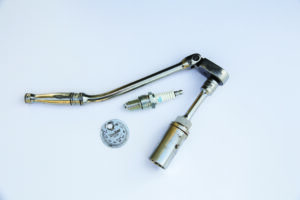 This is why I prefer to install new plugs on the shorter side of the gap spec, so that they remain within spec throughout their lifetime. Fancy Iridium plugs and such use more resistant electrode materials and last longer. Note that a trick to use should you suspect a fouled plug is to lift the spark-plug wire off the sparkplug to create a small gap between the terminal while cranking; this increases the voltage at the sparkplug, which may be enough for the spark to jump the gap and fire up the engine.
This is why I prefer to install new plugs on the shorter side of the gap spec, so that they remain within spec throughout their lifetime. Fancy Iridium plugs and such use more resistant electrode materials and last longer. Note that a trick to use should you suspect a fouled plug is to lift the spark-plug wire off the sparkplug to create a small gap between the terminal while cranking; this increases the voltage at the sparkplug, which may be enough for the spark to jump the gap and fire up the engine.
Manufacturers provide replacement intervals, but in reality, a plug is due when the electrodes get rounded and the gap gets too wide. Maybe it’s time to take a look.









